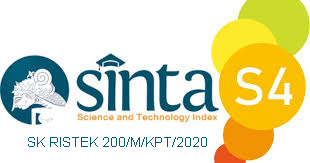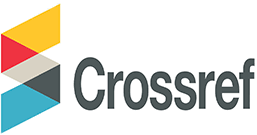The Design of a Monitoring Application System for The Production of Foam Products Using the UML And Waterfall Methods
Abstract
The development of information technology, which is followed by a higher level of competition in the foam product industry, encouraging companies to manage their company's resources properly and to plan effective, systematic and mature activities within the company. As a company with a variety of products, the most dominant problem is in the productivity process. Production is the most important part of a manufacturing company, where in carrying out its production activities this company produces based on orders from customers (Job Orders). And the problems that often occur are planning revisions in the midst of production and changing production schedules between groups (lines), delays in production planning in terms of prioritizing planning, and still being done manually in making daily reports. By implementing monitoring, which is the supervision and control of an activity where measurements and evaluations are completed repeatedly from time to time, monitoring is carried out for the purposes of the company and to maintain ongoing management. Monitoring will provide information about the status and trend of production activities towards the company's goals. The solution to this production problem is to build a web-based foam product production monitoring system application using the Waterfall method which is integrated with UML the method used is use case diagrams, activity diagrams, sequence diagrams, class diagrams and component diagrams and software development with PHP and MySQL technology. With Black box testing, it is proven that the design of this foam production monitoring system application can assist the company's foam product production activities in fulfilling customer orders and accurate reports so that it becomes effective and efficient. in improving the productivity and performance of the company.
Keywords
Full Text:
PDFReferences
X. Zhang, B. Zheng and L. Pan, "Using Virtual Reality Technology to Visualize Management of College Assets in the Internet of Things Environment," in IEEE Access, vol. 8, pp. 157089-157102,2020,doi:10.1109/ACCESS.2020.3019836.
AK Jha, S. Nayak and NK Veerabhadrappa, "An Architecture for Performing Real Time Integrated Health Monitoring of Aircraft Systems Using Avionics Big Data," 2nd International Conference on Computational Systems and Information Technology for Sustainable Solutions (CSITSS), 2017, pp. 1-5, Doi:10.1109/CSITSS.2017.8447679
R. Van Hillo and H. Weigand, "Continuous Auditing & Continuous Monitoring: Continuous Value?" IEEE Tenth International Conference on Research Challenges in Information Science (RCIS), 2016, pp. 1-11, Doi:10.109/RCIS.2016.7549279.
WA Syafei et al., "SMILE (Self-Monitoring Interactive Learning Evaluation) for Indonesian University Students," International Biomedical Instrumentation and Technology Conference (IBITeC), 2019, pp.12-16, Doi: 10.1109/ IBITeC465 97.2019.9091726
AV Demidov, DV Papshev and LY Krivonogov, "Principles of Construction, Structure and Features of the ECG and Blood Pressure Monitoring System," 2020 Moscow Workshop on Electronic and Networking Technologies (MWENT), 2020, pp. 1-5, Doi:10.109/MWENT47943.2020.9067390.
Y. Yang, W. Ke, J. Yang and X. Li, "Integrating UML With Service Refinement for Requirements Modeling and Analysis," in IEEE Access, vol. 7, pp. 11599-11612, 2019, Doi: 10.1109/ACCESS.2019. 2892082.
J. MaIm, F. Ciccozzi, J. Gustafsson, B. Lisper and J. Skoog, "Static Flow Analysis of the Action Language for Foundational UML," IEEE 23rd International Conference on Emerging Technologies & Factory Automation (ETFA), 2018, pp. 161-168, Doi:10.1109/ETFA.2018.8502620.
S. Balaji and MA Obaidy, "Project characteristics used for methodology selection to develop the software project," International Conference on Electrical, Electronics, and Optimization Techniques (ICEEOT), 2016, pp. 3570-3573, Doi: 10.109/ICEEOT.2016.7755370.
A. Hafeez Khan, S. Hyder Abbas Musavi, A. Rehman and A. Shaikh. “Ontology-Based Finite Satisfiability of UML Class Model”, IEEE Access, vol.6, pp.3040-3050. Doi:10.1109/ACCESS.2017 2786781.
Samuel Szoniecky, “Graphical Specifications for Modeling Existence”, in Ecosystems Knowledge: Modeling and Analysis Method for Information and Communication, Wiley, pp.89-115.Doi:10. 1002/978 1119388777.ch4.
L. Ordinez, G. Eggly, M. Micheletto and R. Santos, “Using UML for Learning How to Design and Model Cyber-Physical Systems”. IEEE Revista Iberoamericana de Tecnologias del Aprendizaje (RITA), vol.15, no.1, pp.50-60. Doi:10. 1109/ RITA. 2020.2978416.
SI Adam and S. Andolo, “A New PHP Web Application Development Framework Based on MVC Architectural Pattern and Ajax Technology”. 1st International Conference on Cybernetics and Intelligent Systems (ICORIS), pp. 45-50, Doi:10.1109/ ICORIS. 2019.8874912.
MM Eyada, W. Saber, MM El Genidy and F. Amer, “Performance Evaluation of IoT Data Management Using MongoDB Versus MySQL Databases in Different Cloud Environments”. IEEE Access, vol.8, pp.110656-110668.Doi:10.1109/ACCESS.2020. 3002164.
Pressman R, S, “Software Engineering”, Publisher Andi Yogyakarta, (2015) Page 42.
TH Chang, J. Larson, LT Watson and TCH Lux, “Managing Computationally Expensive Blackbox Multiobjective Optimization Problems with Libensemble”, Spring Simulation Conference (SpringSim), (2020) pp.1-12. Doi:10.22360/ SpringSim. 2020.HPC.001.
J.Pan, “Blackbox Trojanising of Deep Learning Models: Using Non-Intrusive Network Structure and Binary Alterations”, IEEE Region 10 Conference (TENCON), (2020), pp.891-896. Doi:10.1109 /TENCON50793.2020.9293933.
R Guidotti, A Monneale, F Giannotti, D Pedreschi, S Ruggieri F Turini, (2019),” Factual and Counterfactual Explanations for Black Box Decision Making”, IEEE Intelligent Systems, Vol 34, No6, pp,14-23. Doi:10.1109/MIS.2019.2957223
DOI: https://doi.org/10.31326/jisa.v4i2.1045
Refbacks
- There are currently no refbacks.
Copyright (c) 2021 Henny Yulianti, Gatot Tri Pranoto

This work is licensed under a Creative Commons Attribution-ShareAlike 4.0 International License.
JOURNAL IDENTITY
Journal Name: JISA (Jurnal Informatika dan Sains)
e-ISSN: 2614-8404, p-ISSN: 2776-3234
Publisher: Program Studi Teknik Informatika Universitas Trilogi
Publication Schedule: June and December
Language: English
APC: The Journal Charges Fees for Publishing
Indexing: EBSCO , DOAJ, Google Scholar, Arsip Relawan Jurnal Indonesia, Directory of Research Journals Indexing, Index Copernicus International, PKP Index, Science and Technology Index (SINTA, S4) , Garuda Index
OAI address: http://trilogi.ac.id/journal/ks/index.php/JISA/oai
Contact: jisa@trilogi.ac.id
Sponsored by: DOI – Digital Object Identifier Crossref, Universitas Trilogi
In Collaboration With: Indonesian Artificial Intelligent Ecosystem(IAIE), Relawan Jurnal Indonesia, Jurnal Teknologi dan Sistem Komputer (JTSiskom)
JISA (Jurnal Informatika dan Sains) is Published by Program Studi Teknik Informatika, Universitas Trilogi under Creative Commons Attribution-ShareAlike 4.0 International License.


















